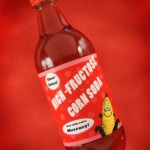I knew that sugars are found naturally in milk, fruits, vegetables and honey. MedlinePlus, from the NIH's National Library of Medicine has a brief discussion of those natural sugars. I also knew that glucose was absorbed in the small intestine and leads to the pancreas putting out insulin. It's eventually converted to energy, though some may be stored in another form in the liver and muscles until needed.
But before I get to the artificial sweeteners, I needed to read more about fructose, the other half of table sugar. My first source, a Mayo Clinic article, didn't make it to be much of a villain, but then I started to put the whole picture together. To start with, table sugar is half glucose and half fructose. The two "simple sugars," called monosaccharides by chemists, have the same chemical formula with six carbon atoms, twelve hydrogens and six oxygens, but the way those are arranged is quite different. They each supply four Kilocalories per gram or fifteen per teaspoonful (That's technically correct, but most of us just use the term "calories.").
If you taste table sugar and call it a "one" in terms of how sweet it is, glucose is about three-fourths as sweet and fructose is nearly one and three-fourths as sweet. Both are considerably sweeter than lactose, the kind of sugar found in milk. Fructose is also easier to dissolve in water and hangs on to water better; that's apparently how it can lengthen the shelf life of baked goods.
That's not why I think high-fructose corn syrup (HFCS) became ever-present in sodas, other sweetened beverages and processed goods. In a blog post I wrote many months ago, I mentioned that after WWII our government wanted to find a way to use two kinds of war-time chemicals; they eventually became pesticides and fertilizers. Corn turned out to be an extremely efficient plant in turning sunlight to stored energy, so it was subsidized. Eventually that led to "monoculture, huge farms raising nothing but corn.
Like any other industry, the corn producers needed to make a profit and have their stock prices increase. That resulted in HFCS being produced and added to lots and lots of food and beverage items.
So what? A 2208 article in Science Daily gave me a clue. The way our bodies handle fructose is considerably more complex than that of glucose. The two simple sugars are separated from each other in the small bowel and glucose quickly passes through the liver on its way to all the other spots in the body where it can become energy. Fructose, according to scientists, makes the liver work harder and there's some data pointing toward its triggering the production of fat.
And we don't just get straight fructose in our diets: HFCS, according to the USDA, is about one fourth water and the rest dissolved sugars. HFCS42 (with 42% fructose) is added to many products, especially processed foods. HFCS55 (with 55% fructose) is added to soft drinks. It's roughly comparable in sweetness to table sugar; the issue is why do you need to ingest any more sugar?
There's been more research in this area and I'll cover that in my next post.
Tags: fat production, HFCS, high-fructose corn syrup, metabolism of sugars


